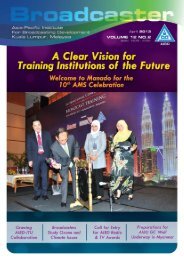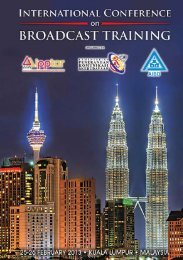SUMMIT
New Visions Asia Media Summit 2008 - AIBD
New Visions Asia Media Summit 2008 - AIBD
- No tags were found...
You also want an ePaper? Increase the reach of your titles
YUMPU automatically turns print PDFs into web optimized ePapers that Google loves.
Changing Newsrooms, Redefining<br />
Journalism:<br />
New ‘Mediagogy for the Oppressed’<br />
Saed Jamal Abu-Hijleh<br />
New advancements in Informaon and Communicaons Technologies (ICTs) are dramacally<br />
changing the media landscape. Major developments in the electronic media are<br />
occurring at unprecedented rate creang new interconnected plaorms that offer wider<br />
public parcipaon. An ongoing revoluon in digital technologies is radically altering<br />
paerns of news producon and consumpon on the local, regional, and internaonal<br />
levels.<br />
The Internet has been transformed into a mul-layered and interconnected media<br />
plaorm facilitang beer flow of informaon and enhanced sharing of content in different<br />
formats. The Internet developed from a medium that allowed the interacon between<br />
one-to-one, then one-to-many, and now many-to-many. Web 2.0 is the term used to<br />
describe the development in the World Wide Web infrastructure and web-design soware<br />
that led to the evoluon of web-based communies. These developments resulted in a<br />
massive increase in User-Generated Content (UGC) on the internet that can be found on<br />
weblogs, newsgroups, mailing lists, bullen boards, chat forums, and independent news<br />
websites.<br />
Accordingly, new forms of parcipatory journalism have emerged expressed in an explosion<br />
in the number of blogs and cizens’ journalism 1 websites that started to challenge the<br />
monopoly and hegemony of mainstream media on, what I call, news producon assembly<br />
lines, and to challenge the ability of the big media conglomerates to set the global news<br />
agendas determiniscally as has been the case for many years in the past.<br />
These changes are creang more opportunies for broader parcipaon from marginalized<br />
and colonized communies around the world. More space is available for these<br />
communies to report on unreported, misreported, or underreported news in their locali-<br />
es.<br />
Since mass media, especially the news media, has always been used in the process of the<br />
reproducon of oppressive socioeconomic and sociopolical orders by serving the<br />
interest of the elites in society, the disenfranchised people around the world must ulise<br />
these changes in media landscapes and plaorms to parcipate more in the newsproduc-<br />
on assembly lines. What is needed is what I dare to call a new ‘Mediagogy of the<br />
Oppressed’ .<br />
1<br />
Many argue that the term “cizens’ journalism” should be replaced with terms like “grassroots journalism”,<br />
“people’sjournalism”, or “parcipatory journalism”, since there are millions around the world who are considered<br />
stateless or without cizenship (like refugees or illegal immigrants).<br />
33








